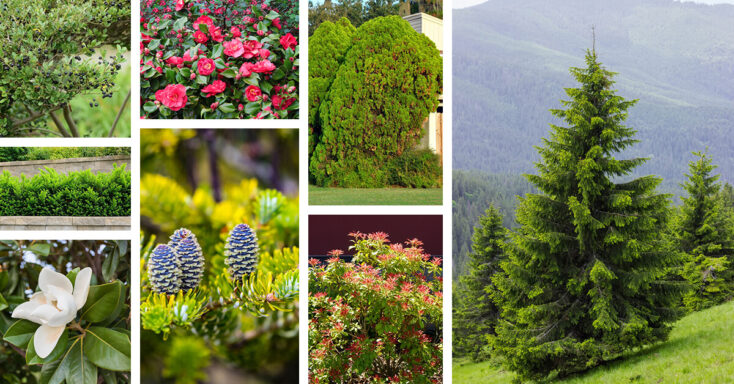At times, it can be difficult and frustrating to find plants that remain vibrant all year long and are able to tolerate shade. If you have ever felt yourself struggling with that issue, then you have come to the right place. We have taken the time to assemble this list of the best shade-tolerant evergreen trees for your convenience. Admittedly, there are very few trees, evergreen or otherwise, that are tolerant of full shade conditions. However, as our list will prove, there are plenty of evergreen tree options for areas that receive partial shade or filtered light. Read on to discover what those trees are and the unique ornamental features that make them stand out from one another.
Key Takeaways
As is the case for all of our lists, this list of shade-tolerant evergreen trees will provide you with plenty of disparate facts and insights about the species we’ll present. But what’s also true is that you’ll find certain broad overarching facts reappear as a consistent theme throughout the article. Below are the 5 most important of those thematic facts that you should review before you move on to selecting the best shade-tolerant evergreen tree for you.
- Evergreen trees can have needles or broad leaves.
- Some evergreen trees bloom with beautiful flowers.
- Shade-tolerant evergreen trees belong to an incredibly wide range of species and genera.
- Some evergreen trees are much more shade tolerant than others.
- Evergreens can act as hedge plants, background greenery, or garden focal points.
24 Effective Shade-Tolerant Evergreen Trees that are Both Functional and Beautiful
1. American Holly (Ilex opaca)
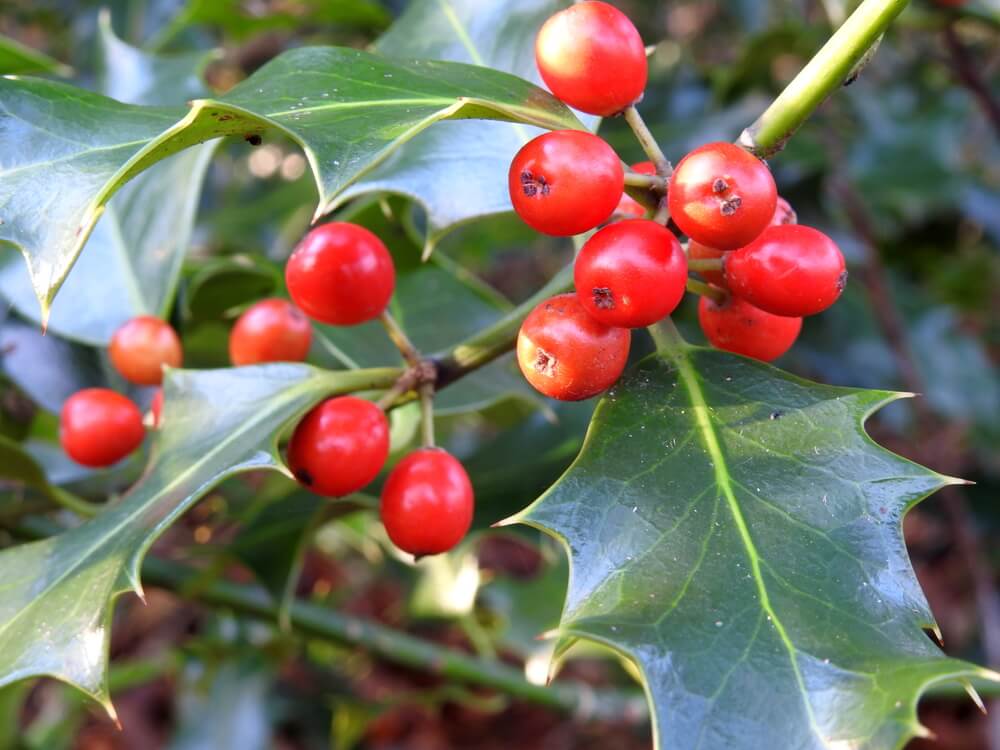
The American holly is not only a popular source of winter holiday decoration, but it is also a plant that looks great all year long and can grow well in partial shade settings. American holly plants can grow in a shrub-like form depending on how you prune them, but if you let them mature naturally, they will achieve a tree-like form and an overall height that can surpass 40 feet. No matter what growth stage this plant is in, it will continually provide ornamental appeal via its glossy evergreen leaves and its persistent bright red fruits.
2. Japanese Holly (Ilex crenata)

After kicking off our list with the American holly, it is only fitting that we introduce its Japanese counterpart as well. The Japanese holly is a separate species from the American version but comes from the same genus. Despite that, you’ll notice some key appearance differences between these plants. Mainly, the evergreen leaves of a Japanese holly are smaller, lighter in color, and rounder overall.
Also, while the American holly’s fruits are red, those that belong to the Japanese holly are nearly black.
3. Canadian Hemlock (Tsuga canadensis)
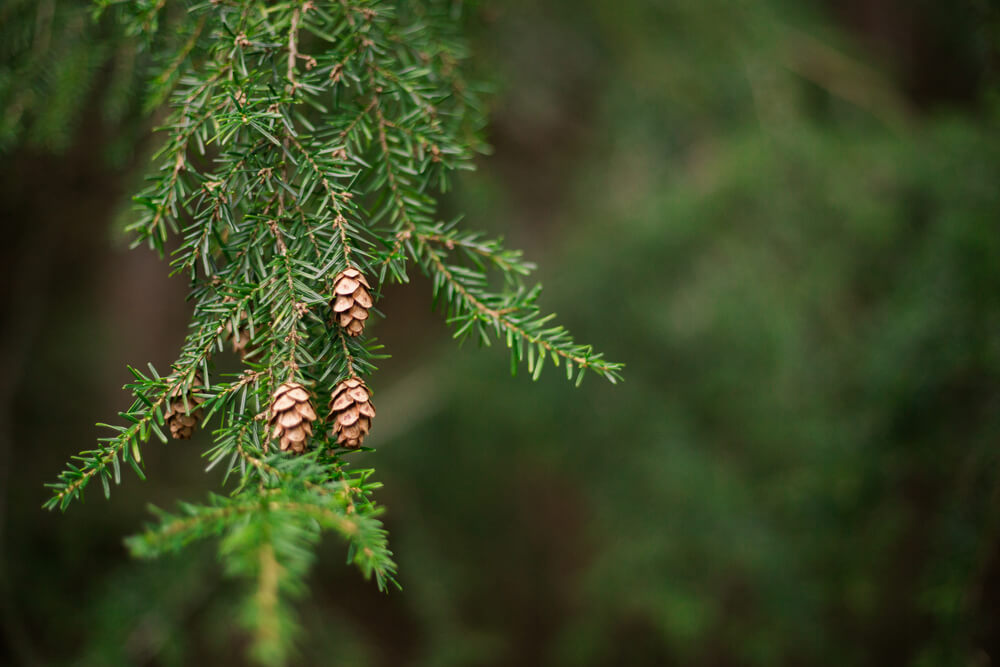
This plant is a main feature of the landscape throughout many parts of the eastern United States and Canada. In that range, the Canadian hemlock thrives in forest settings where full sunlight is not always available. In that same setting, the Canadian hemlock is also a valuable member of the ecosystem, providing food and shelter for several forms of wildlife. Beyond that ecological value, the Canadian hemlock is also quite an attractive plant. It has short evergreen needles, a form that is loosely pyramidal, and an adorable set of tiny cones that dangle from the branches.
4. Japanese Yew (Taxus cuspidate)
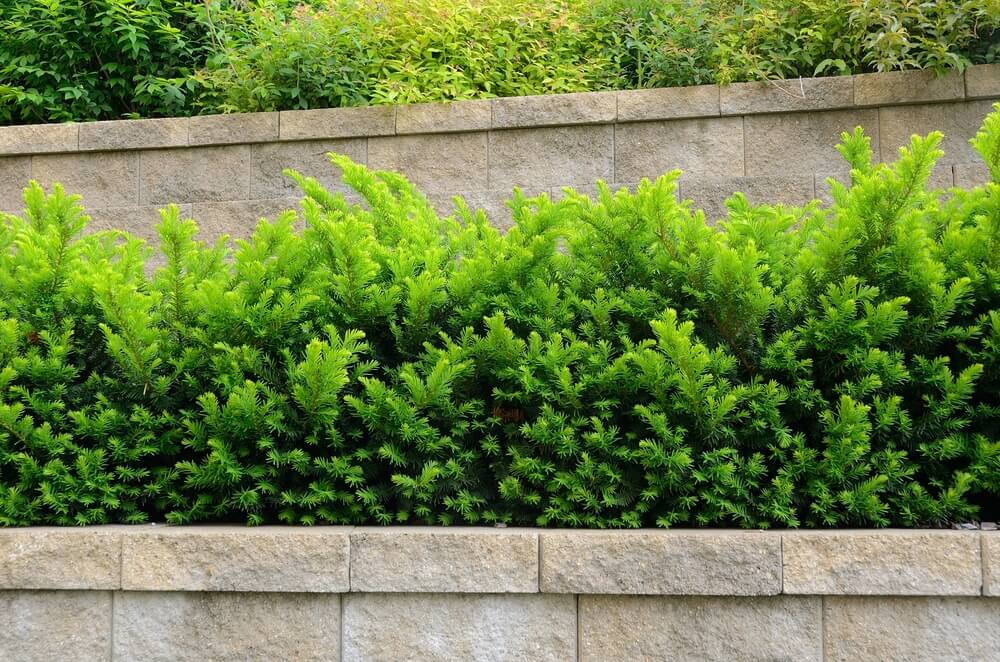
The goal of this list is not to point out a winner among the best evergreen trees for shade. However, it is difficult to find a plant that scores higher on reliability in low-light conditions than the Japanese yew. While this plant prefers partial shade, it can also live in full-shade settings without looking any worse for wear. The Japanese yew is also an incredible hedge plant since it has dense foliage that responds well to shearing and shaping. You’ll also notice that this tree has bright red fruits that are ornamentally appealing as well.
5. Chinese Fringe Flower (Loropetalum chinense)
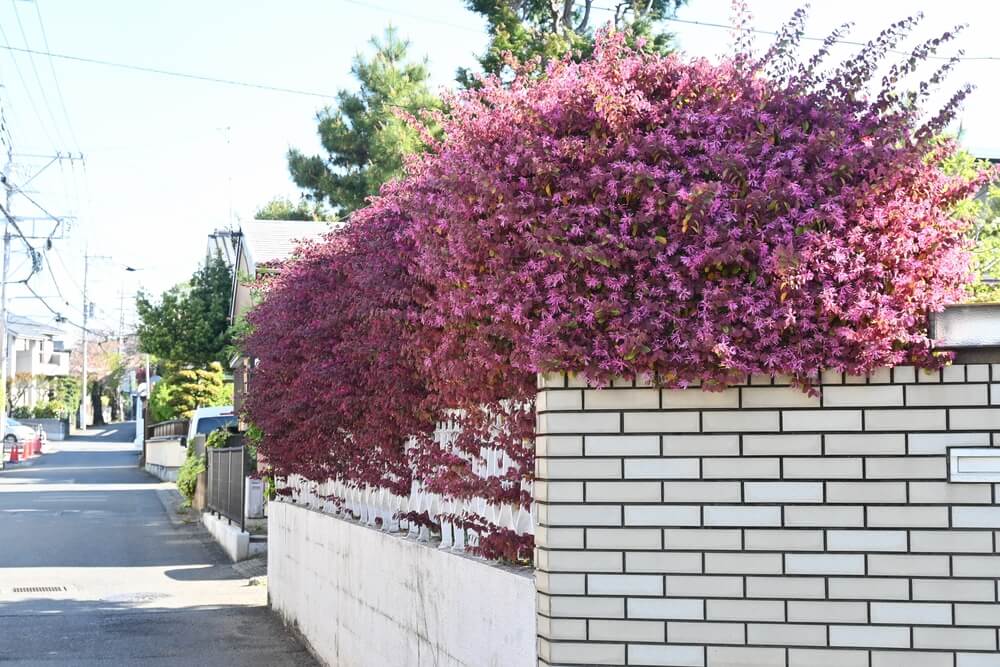
Since there are fewer plants that grow well in shaded areas, many gardeners believe that the shadier areas of their yards are destined to be colorless and uninteresting. However, this list entry begins to show that there are at least a few trees that will live well in the shade while also adding color to the landscape. The Chinese fringe flower plant is certainly among those colorful shade-dwelling tree options. This plant blooms across its entire canopy with vibrant magenta flowers that have long spindly petals. The leaves of this plant look great as well. At times, they seem to have a slight purple hue to them as well.
6. Boxwood (Buxus)
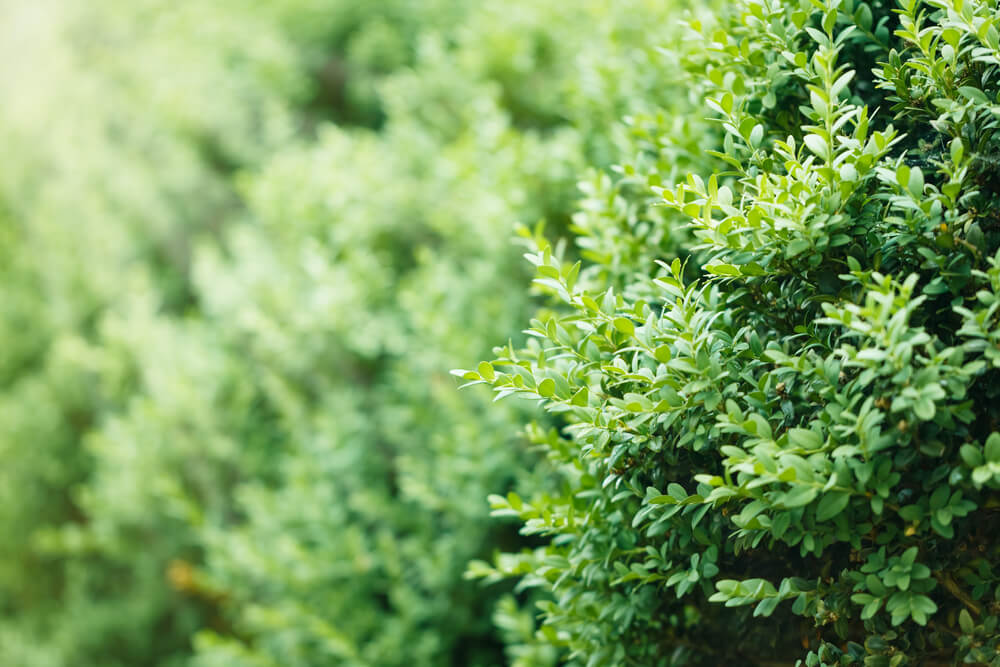
Boxwood shrubs are not only great evergreen plants to grow in the shade, but they are also among the most popular broadleaf evergreens overall. What allows these plants to remain continually in style is their incredible responsiveness to shearing, which allows gardeners to trim them into nearly any shape imaginable. Notice that we pointed out boxwoods as a genus of plants. The reason is that there are many specific cultivars for you to choose from, some of which are more tolerant of shade than others, as you will find. One of the best boxwood varieties for areas that are a bit shady is one known as the Green Mountain boxwood.
7. White Fir (Abies concolor)

The white fir tree is the first of a few needled evergreen trees on this list that can act as a quintessential Christmas tree due to its almost perfect conical form. However, the white fir tree stands out from those other options for multiple reasons. One is that the needles of this tree are surprisingly bright. At times, they appear nearly vibrant compared to other evergreens. Additionally, unlike other similar plants, white fir trees have needles that are very soft to the touch, which makes them easy to handle while you maintain this shade-tolerant tree.
8. Korean Fir (Abies koreana)
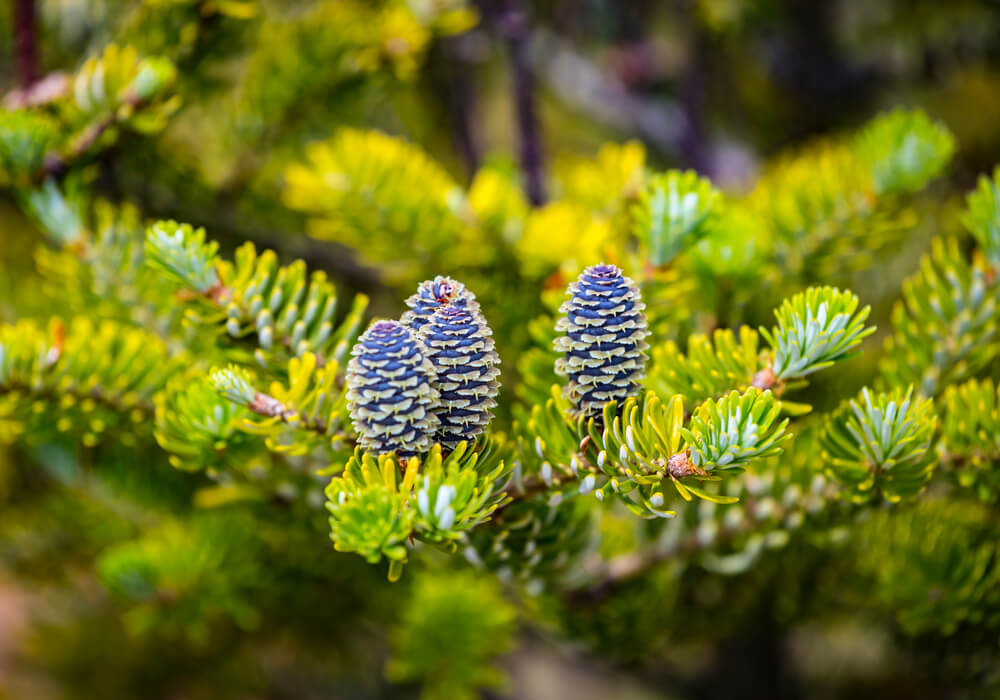
If you thought the white fir tree stood out in stark contrast to other evergreens, you’d be even more captivated by the Korean fir. This tree not only has bright needles, but it also has cones that are unlike those of nearly any other tree. Those cones face upward, appear in clusters, and have a deep blue color that makes for a great contrast to the foliage. Like the other fir we just mentioned, this one also has a natural growth habit that creates a neat conical form.
9. White Spruce (Picea glauca)
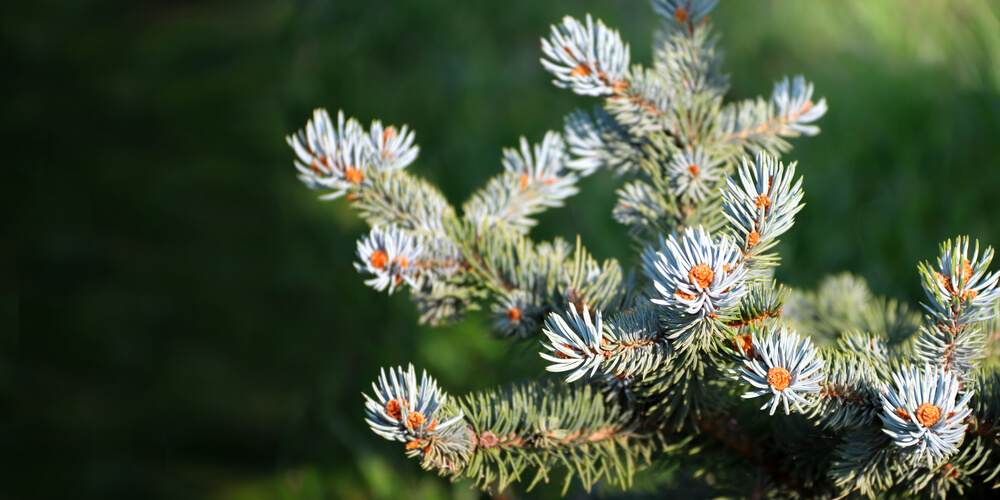
It’s true that the white spruce prefers to live in areas that receive full sunlight. However, this plant can tolerate partial shade and proves to be a dependable planting choice for several other reasons as well. For instance, the white spruce tree can adapt to many different soil types, including soils with different consistencies and acidity levels. The white spruce tree is also a large species that grows quickly, which means it can help add privacy to your yard more quickly than many other options.
10. Norway Spruce (Picea abies)

The Norway spruce is another incredibly tall evergreen tree that can tolerate partial shade. At times, it can be quite easy to pick out a Norway spruce from other spruce varieties because the Norway spruce branches that have a somewhat pendulous habit. Likewise, the cones of this tree also dangle and are quite long compared to the cones of other trees. Also, Norway spruce needles tend to be on the darker side, which gives the canopy a rich texture and hue. Thanks to the overall shape and hanging nature of the branches, the Norway spruce tree is one of the best plants for cold climates since it can shed show effectively.
11. Japanese Pieris (Pieris japonica)
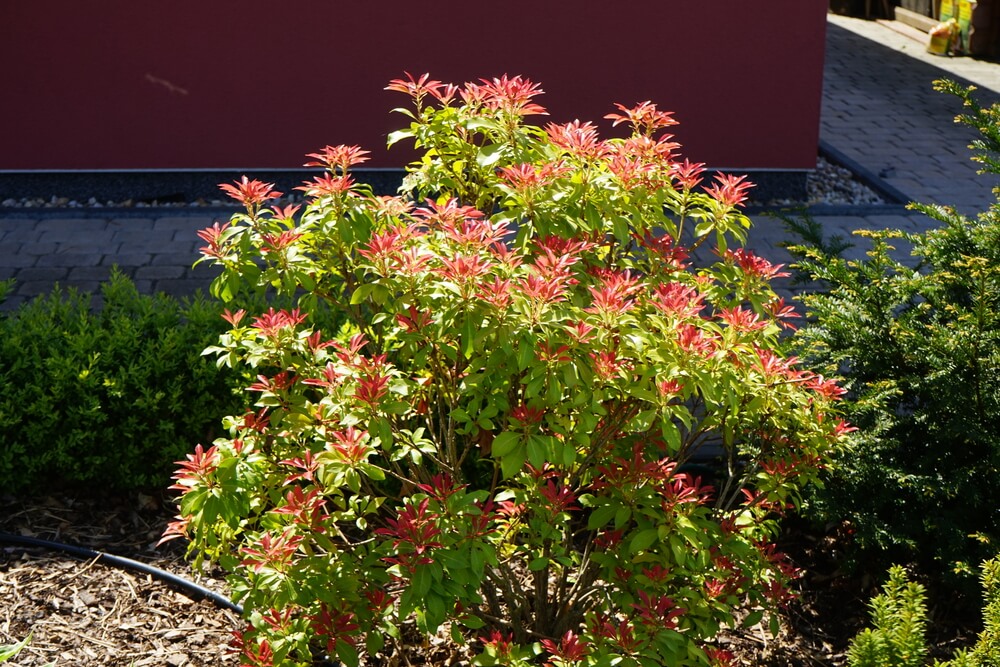
Some may argue that the Japanese pieris is more of a shrub than a tree. However, since this species can grow to be more than 12 feet tall, we think it is safe to say that it lives somewhere between large shrub and small tree classifications. What is not as debatable is this plant’s ability to survive in shady conditions. Wherever you have a shadier area of your yard, you can expect your Japanese pieris to thrive while adding broad evergreen leaves. The Japanese pieris also blooms with a set of unique flowers that are bell-shaped and dangle in clusters over the foliage.
12. Blue Gum Tree (Eucalyptus globulus)
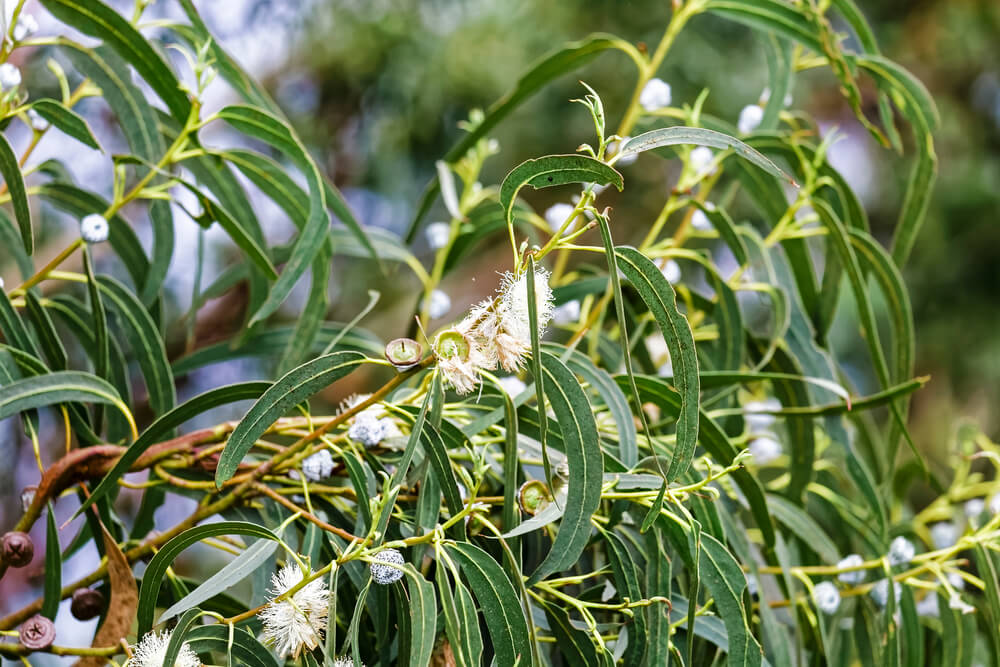
The blue gum tree is a plant that will certainly stand out from most that grow throughout the landscapes of the United States. The reason for that is that this species, and others in the Eucalyptus genus, come from Australia. Due to that native range, the blue gum tree prefers a warmer climate and can only survive in hardiness zones 8 or warmer. Nevertheless, the blue gum tree remains tolerant of partial shade conditions and is also a fast-growing species.
13. Rosebay Rhododendron (Rhododendron maximum)
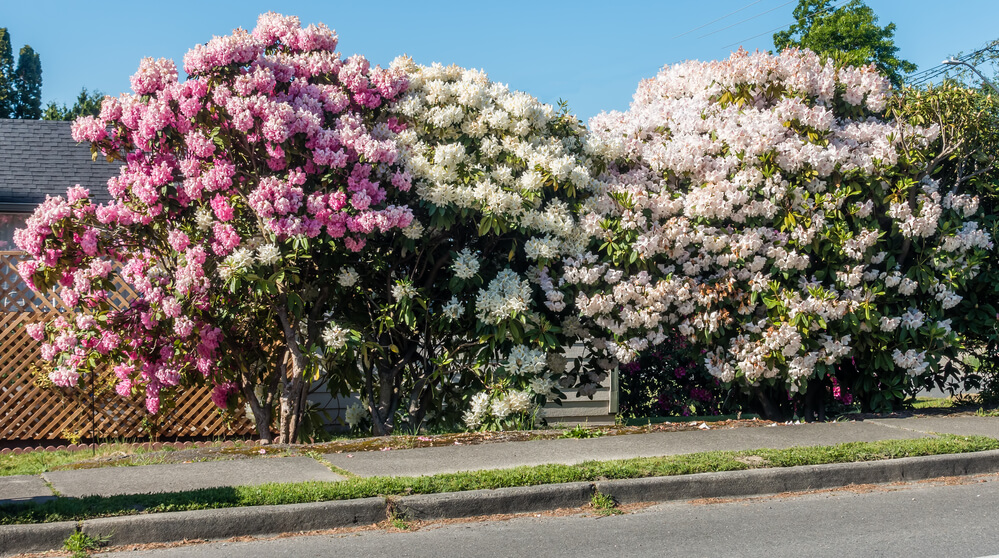
There are thousands of rhododendrons and rhododendron cultivars that not only exist but are popular in the nursery trade. Among those many options, the rosebay rhododendron is one of the original native species that thrive throughout the eastern United States. It is also one of the few species that is distinctly large enough, about 20 feet tall at maturity, to truly call it a tree. This plant blooms with large bunches of flowers, and you’ll often find it adapts incredibly well to the shaded areas under tall tree canopies.
14. Camellia (Camellia japonica)

Whether you are seeking a tree that tolerates shade or not, the camellia is one of the most attractive small trees that you can choose to grow. This elegant species often show a multi-stemmed habit of graceful trunks that holds a rounded canopy of glossy, broad, evergreen leaves. When in bloom, the camellia sets itself apart from almost any other plant with solitary rose-like flowers that come in shades like white, pink, and red. Those traits alone are enough to sell most plant enthusiasts, but for the purpose of this list, it’s worth noting that camellias look and grow their best in shaded conditions.
15. Mountain Laurel (Kalmia latifolia)
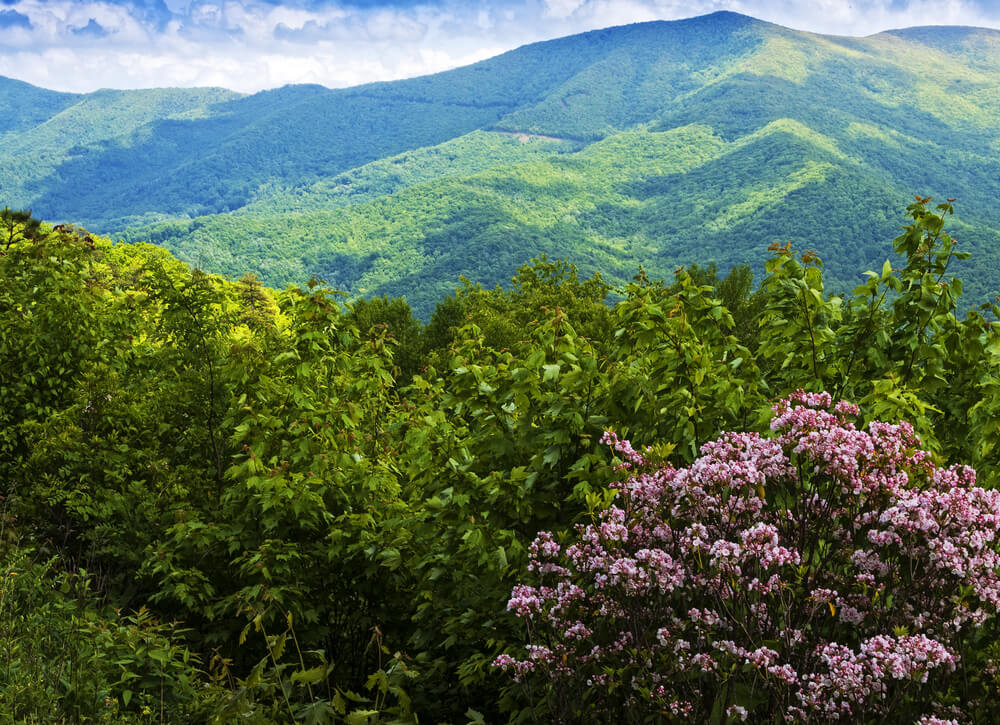
Mountain laurel is another broadleaved evergreen tree that has a remarkable ability to survive in shade. In fact, this tree can live in full shade in many cases and begins to suffer when it gets too much light, which often results in leaf scorch. What’s equally impressive is that the mountain laurel has fantastic blooms that help to round out the spring season. They bloom in June and have a unique geometric shape and a shade that varies from white to varying shades of pink.
16. Anise Tree (Illicium parviflorum)
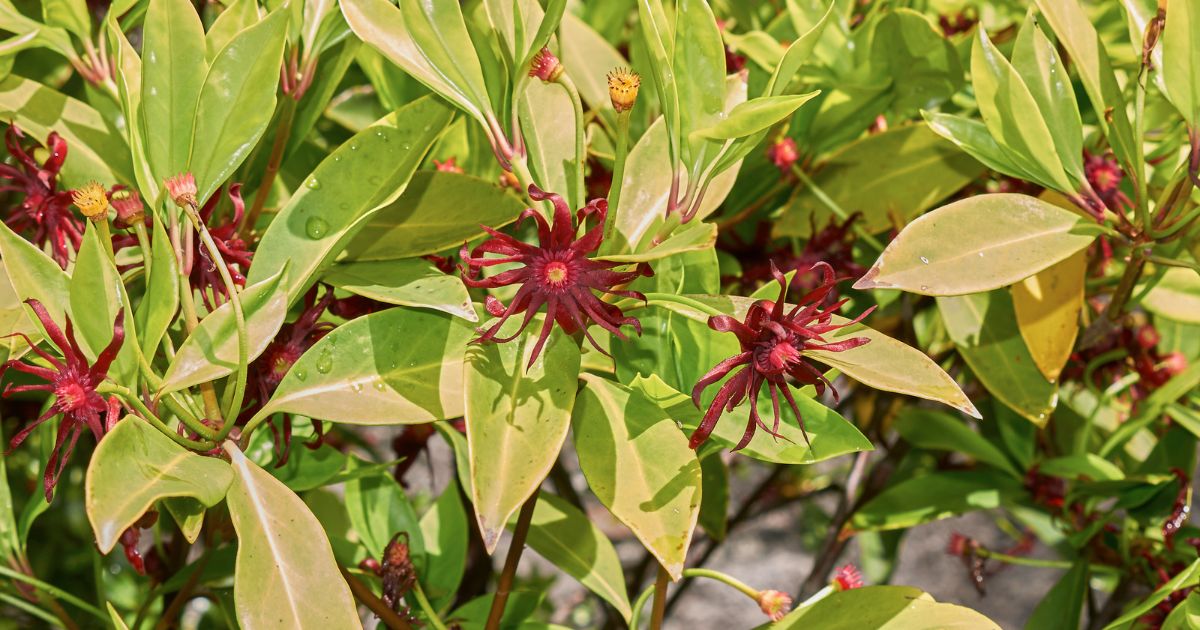
The evergreen leaves of the anise tree are perhaps the most noteworthy part of this shade-tolerant tree. Those leaves form a nearly perfect oval shape and stand out at a rigid, almost upright angle. They are also relatively soft when young and give off a distinct scent when they break. Below those showy leaves live the subtle round yellow blooms that the anise tree produces. While producing those features, this species is perfectly happy to live in full-shade settings as well.
17. Eastern Arborvitae (Thuja occidentalis)
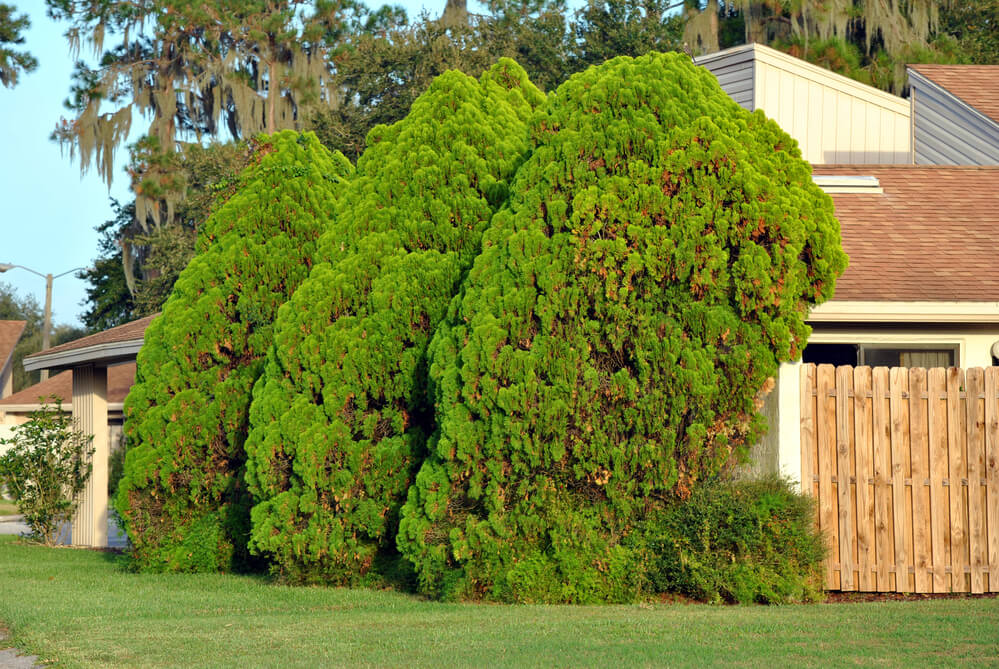
For those who want an evergreen tree that is great for privacy and easy to care for, look no further than the eastern arborvitae. Due to its reliability and adaptability, the eastern arborvitae is one of the most ubiquitous plants in residential landscapes. It makes for the ideal privacy hedge and can block wind effectively as well. You won’t need to wait long for your hedge to form either since the eastern arborvitae maintains a quick growth habit throughout most of its life.
18. Western Arborvitae (Thuja plicata)
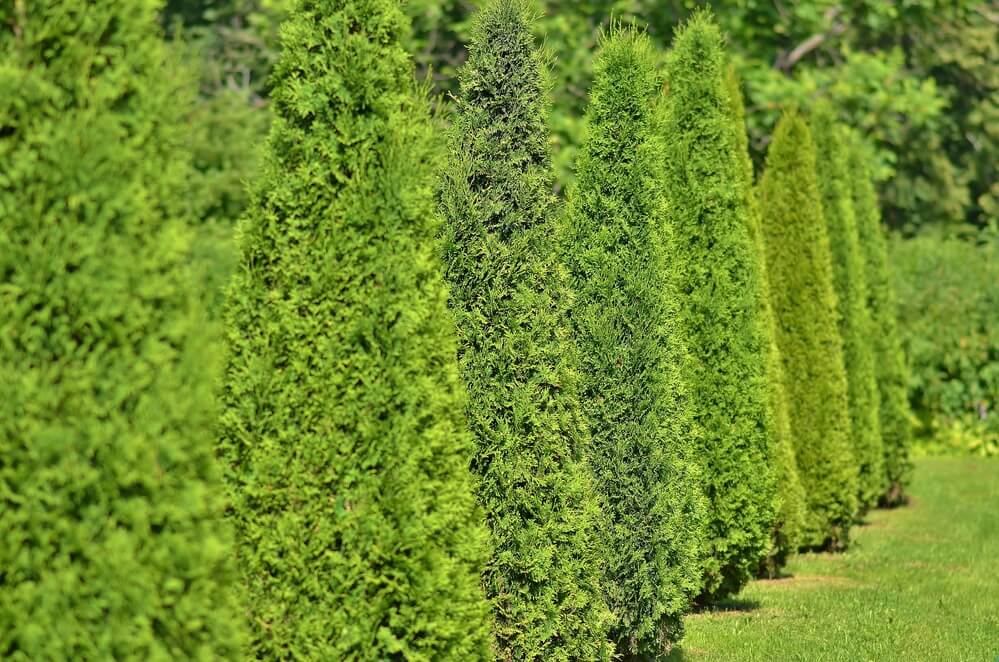
Since the eastern arborvitae serves as a go-to hedge plant throughout the eastern half of the US, it is only fitting that a version exists for the western part as well. The western arborvitae, also known as the western red cedar, is incredibly similar to its eastern relative in all the right ways. This plant has dense evergreen foliage and is easy to care for. It also has great cold hardiness and does not often face problems related to deer browsing.
19. Southern Magnolia (Magnolia grandiflora)
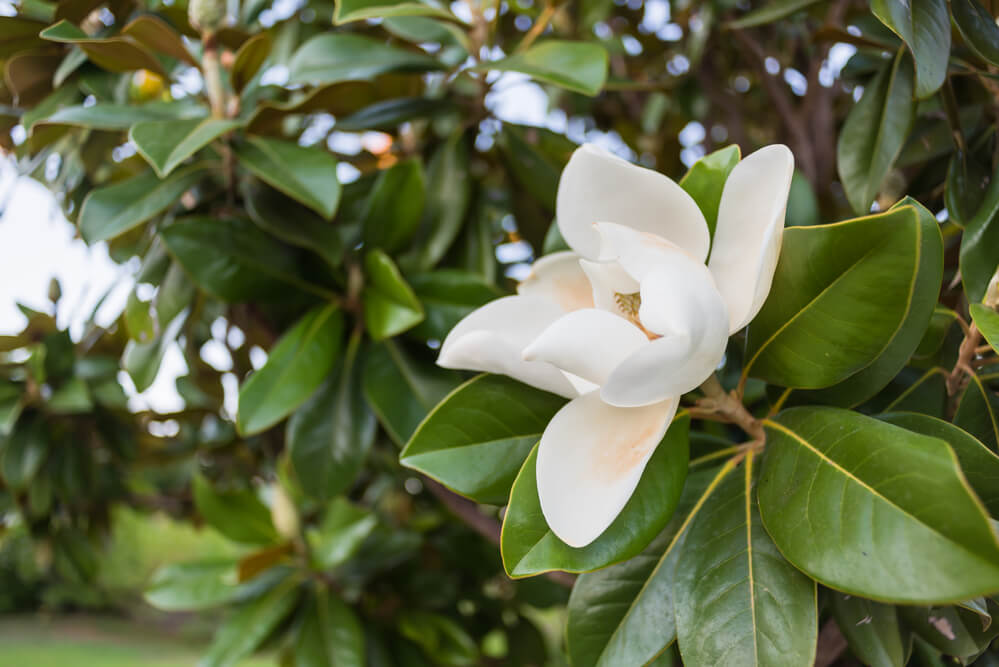
The southern magnolia tree is an incredibly popular species due to its unique combination of size and subtle beauty. In the right growing conditions, the southern magnolia can reach 80 feet tall and about half as wide at maturity. Throughout its life, this tree will also bloom with magnificent flowers that have large creamy petals that curve gently toward the center. With the beauty of those flowers noted, we should also mention that this tree has beautiful evergreen foliage as well. Those leaves are relatively large and very shiny on the surface as well.
20. Common Juniper (Juniperus communis)
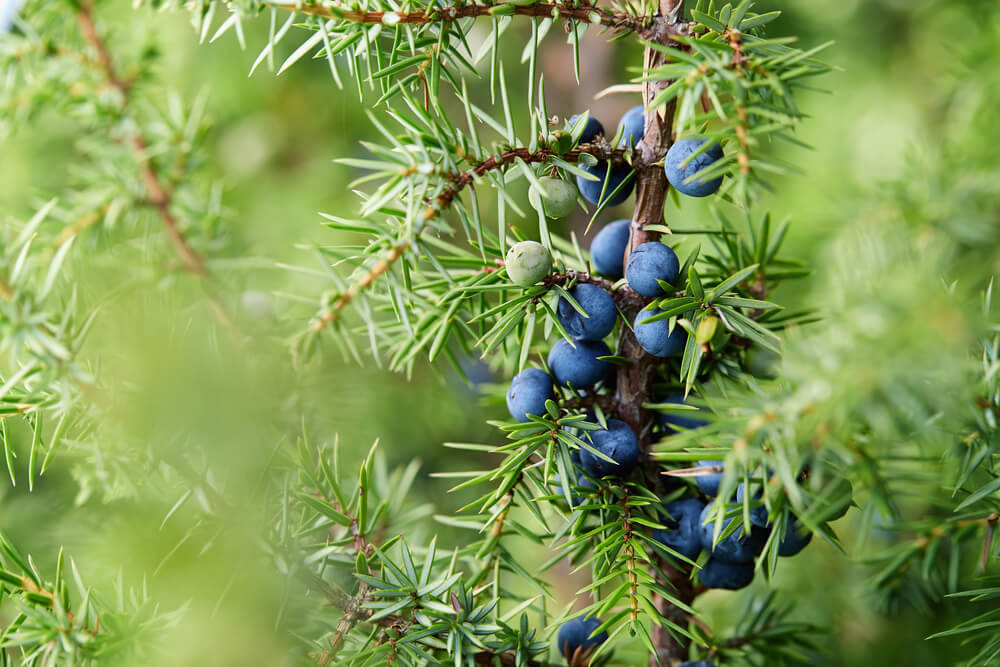
Although it may at first appear common in both name and appearance, the common juniper is anything but when you take a closer look. This tree has rough foliage that makes for a beautiful texture with a lot of depth and shadow. This plant also has excellent fruits, which are small, berry-like, and light blue in color. At times, a common juniper tree can have a somewhat wild and irregular form. However, with proper pruning, you can turn this plant’s form into a neat oval shape with relative ease.
21. Eastern White Pine (Pinus strobus)
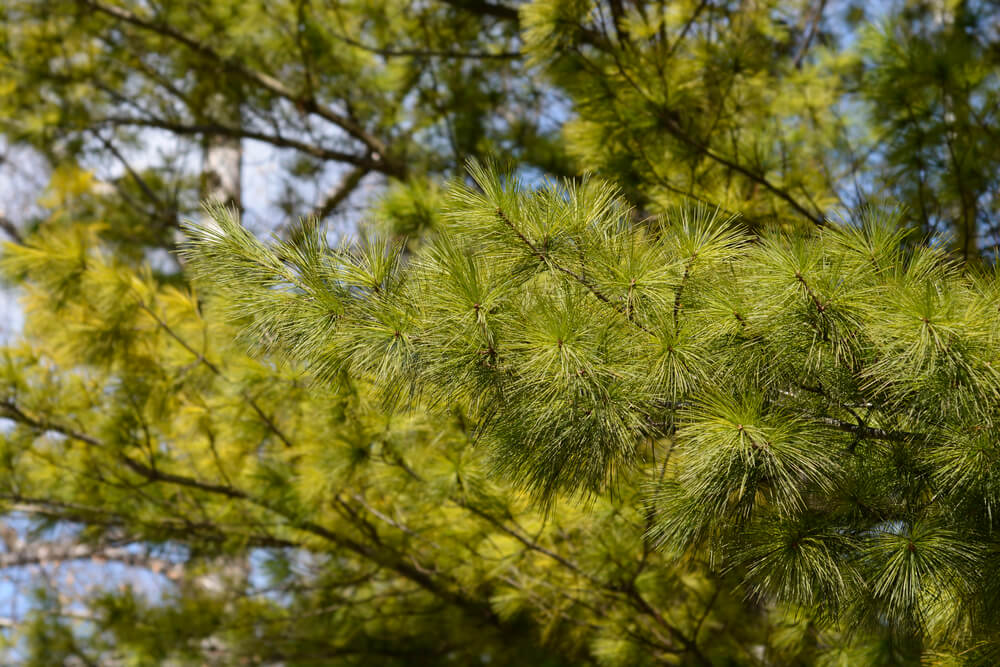
The eastern white pine tree is another species that is equally likely to grow in wild settings as it is to grow in someone’s backyard. This tree tends to have a single straight trunk that holds a somewhat irregular canopy. Within that canopy, you’ll find many long, slender needles, held in groups of five, that make an excellent foliage texture and look incredible when the light passes through them.
Fortunately, the eastern white pine tree is also a fast-growing tree. During its youth, it will make for a great hedge plant, and as it ages, it will provide shade.
22. Dwarf Mugo Pine (Pinus mugo)
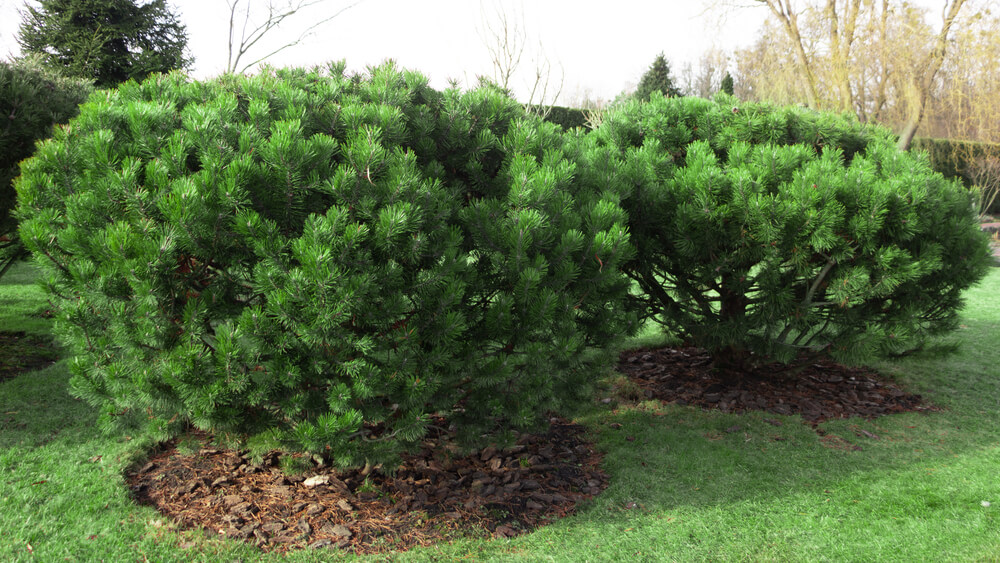
Although it is a dwarf tree, it is a tree nonetheless. The dwarf Mugo pine is a squat plant that tends to grow as much horizontally as it does vertically. This plant is also tolerant of some difficult growing conditions, as you can find it growing in some rockier areas where less durable plants might suffer. The Dwarf Mugo pine also offers some subtle but interesting color contrast. Most of its canopy consists of thick dark green needles that contribute to a fuzzy overall texture. Within that canopy, you’ll also find bright upright yellow candles at the end of each branch, which are the Dwarf Mugo pine’s new growth.
23. Lawson Cypress (Chamaecyparis lawsoniana)
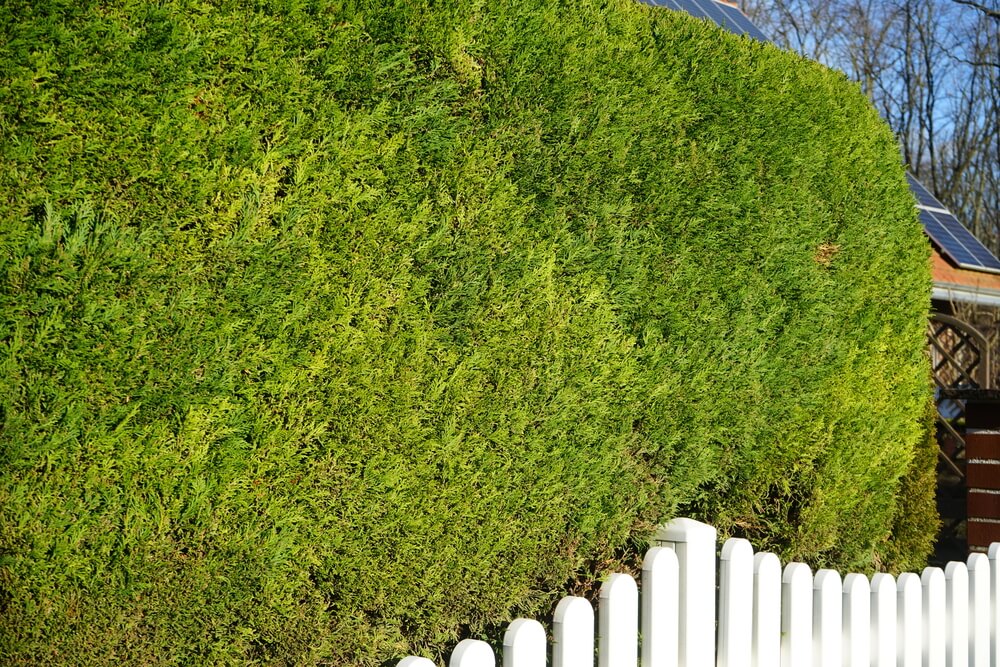
Many evergreen plants quickly fall into the hedge plant category. And while we need plenty of hedge plants to choose from, there are also times when we need our evergreens to stand out as focal points in the garden. The Lawson cypress is a shade-tolerant evergreen tree that is capable of playing either of those roles. Plant multiple Lawson cypress trees in a straight row, and you’ll have a hedge that is as good as any other. Plant a Lawson cypress all on its own, and you’ll get to admire its beautiful foliage and intriguing spire-like form.
24. Live Oak (Quercus virginiana)
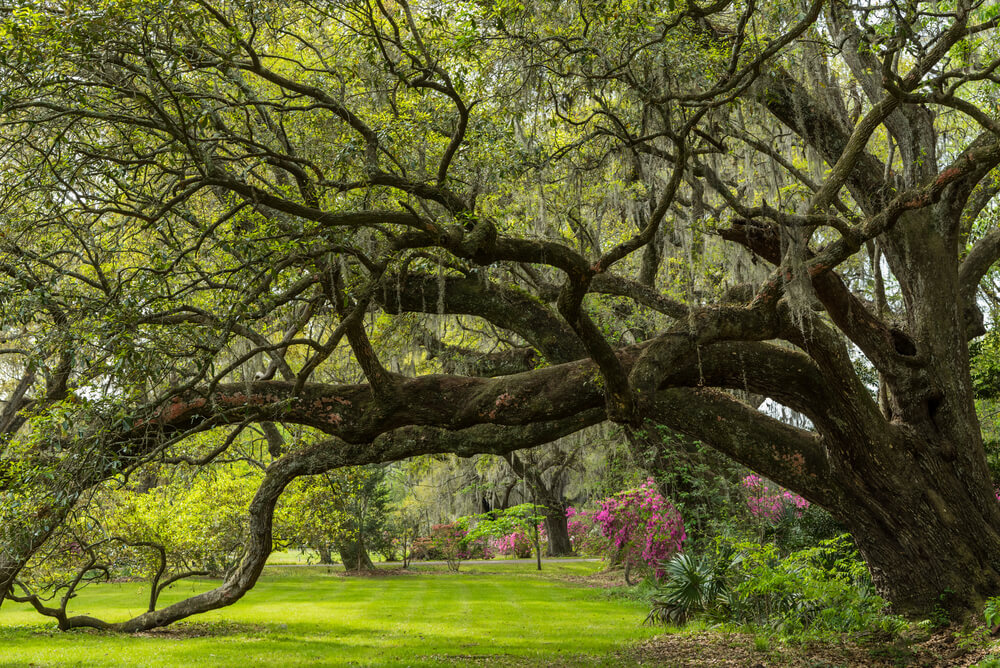
If you are familiar with the American South, then you may know that our final list entry is a staple landscape feature of that region. Those unfamiliar with this tree may mistakenly believe that oaks are entirely deciduous. However, the live oak tree is a large evergreen tree species that can develop in partial shade settings. With the right conditions and care, a live oak tree will eventually cast plenty of shade on its own thanks to its massive spreading canopy.
Frequently Asked Questions About Shade-Tolerant Evergreen Trees
What Are the Most Popular Shade-Tolerant Evergreen Trees for Privacy?
There are several shade-tolerant evergreen trees that are perfect for creating privacy in your yard. Among those options, yew trees may be the most popular. Unlike other shade-tolerant evergreens, yew trees can survive in areas that are nearly fully shaded. Additionally, yew trees have dense needled foliage that is perfect for blocking both sight lines and wind. Beyond yew trees, boxwoods, cypress trees, and arborvitae are very popular for creating privacy but often require partial sun settings.
What Kind of Trees Like Full Shade?
While there are many trees that can tolerate partial shade conditions, there are very few that prefer to live in full shade. In technical terms, full shade settings are areas that receive four hours of sunlight per day or less. Several types of trees will survive with less than four hours of sun exposure but may not look as vigorous as they might when they receive more light. However, some evergreens, including mountain laurel and Japanese camellia, can survive in full shade areas.
What is the Fastest-Growing Shade-Tolerant Evergreen?
It can be hard to find an evergreen tree that survives in exceptionally shady conditions, but it is even more of a challenge to find one that grows at a fast rate in those conditions as well. Fortunately, there are a few plant options that meet all of those characteristics. One of the best examples is the boxwood, which grows at a quick rate and can survive in partial shade settings. Another fast-growing tree that tolerates shade and holds its leaves all year long is the blue gum tree. Those species, and others, show a great ability to maintain a fast growth rate even in the absence of full sun.
What is the Fastest-Growing Shade-Tolerant Evergreen?
It can be hard to find an evergreen tree that survives in exceptionally shady conditions, but it is even more of a challenge to find one that grows at a fast rate in those conditions as well. Fortunately, there are a few plant options that meet all of those characteristics. One of the best examples is the boxwood, which grows at a quick rate and can survive in partial shade settings. Another fast-growing tree that tolerates shade and holds its leaves all year long is the blue gum tree. Those species, and others, show a great ability to maintain a fast growth rate even in the absence of full sun.
What is the Best Privacy Tree for the Low Sun?
No individual species stands out as being the best for privacy in low sunlight settings, but there are plenty of options for you to choose from. One of the most reliable privacy trees on the market today is the arborvitae, which can grow in full sunlight or partial shade. Boxwoods, yew trees, and hollies are also great options for privacy since all of these plants are also evergreen, partially shade-tolerant, and have dense foliage that acts as an effective sound and visual barrier.
Gardeners of varying experience levels can come up with useful questions about shade-tolerant evergreen trees. In response, we’ve provided a few answers to the most common ones below so that you can increase your knowledge of this diverse plant group.
24 Excellent Shade-Tolerant Evergreen Trees that Give Your Garden the Greenery it Needs
It would be a mistake to assume that evergreen trees are some of the more boring plant options around. The truth is that evergreen trees offer a surprising amount of foliage varieties, and they can even show off some incredible flowers and fruits as well. Along with those ornamental features, many evergreen trees serve functional roles in the garden as well, whether that be creating privacy or blocking wind. The good news is that many of those plants can also thrive in areas that don’t receive full sunlight, as our list above of 24 shade-tolerant evergreen trees proves.


